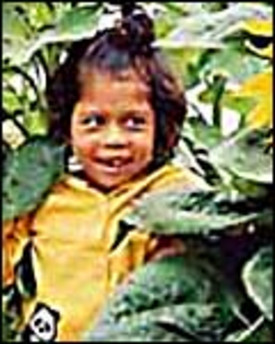 |
||
|
|
The sky is the limit, so help them imagine a garden focused on their special interests, or use a favorite movie or book for inspiration. A Wizard of Oz garden, for example, could include a bed of poppies, a yellow brick path, and a scarecrow.
Here are some more ideas to get the brainstorming started.
Alphabet Gardens
This is a fun idea if you have room for 26 plants. Let your child choose from asters to zinnias, and make signs for each plant. Be sure to consider the Latin name as well as the familiar common names in your search, and be flexible. For example, your child might decide that Queen Anne’s lace could be used for Q, A, or L. If a suitableplant is unavailable or impractical, improvise. Children are very good at this. For instance, your child might decide to include a letter by making a sign with the letter on it, or might include an interesting object that begins with that letter, or even skip it altogether. The letter X is tough, but the lovely dried flower, immortelle, is a good choice. Its Latin name is Xeranthemum.
Dye Plants
A little research will provide lots of ideas for plants used to make dyes, such as brown-eyed Susan, calendula, false indigo, and sunflower. Kids can paint garden stakes the appropriate color to mark each plant’s row or patch, and then delight in dyeing yarn, cloth, or even eggs by creating dyes from the plants they’ve grown.
 |
||
|
|
||
| Geranium |
||
|
|
||
 |
||
|
|
||
| White Alyssum |
||
|
|
||
 |
||
|
|
||
| Blue Lobelia |
||
|
|
Herbs
You can focus on culinary herbs or medicinal herbs or pick a period of history and choose herbs that were important during that period. Kids can have fun uncovering information on the ways herbs have been used historically. For example, during the Middle Ages some herbs, such as lavender, rosemary, and chamomile, were used to mask the odors of spoiled food, poor hygiene, and tooth decay. Kids will undoubtedly discover some plants they just have to try growing and using.
July Fourth
Plan ahead for your local Fourth of July celebration, and you’ll be properly decorated. You may even have a float for the town parade if you plant your garden in a mobile little red wagon. Let red, white, and blue flowers abound. Include a sweet alyssum border, geraniums, lobelia, cosmos, begonias, and impatiens. For the finishing touch, add American flags to the mix.
Native American
One of the best known Native American garden techniques is the interplanting of corn, beans, and squash—a trio considered by the Iroquois Indians of the East as “The Three Sisters.” To plant a typical Three Sisters system, make slightly raised areas (hills) about 12 inches high and 18 inches in diameter 3 to 4 feet apart in all directions. In each hill, plant half a dozen soaked corn seeds in a small circle. As corn plants begin to grow, weed gently, mounding soil up around the plants. When the corn is about 6 inches high, plant 4 to 6 seeds of pole beans around the circle. Then plant 4 or 5 pumpkin or squash seeds either in every seventh hill, or plant a couple of seeds if you have just one hill. (If you plant too many, they’ll overwhelm the other crops.)
Outer Space
Grow vines up a rocket fashioned out of bamboo canes. Hang some handmade stars and planets from the canes and think cosmic when it comes to plants: cosmos, of course, rocket flowers, moonflowers, and ‘Moon and Stars’ watermelon.
Pizza
Plant wheat, garlic, tomatoes, green peppers, onions, and more in wedge-shaped patches so together they form a giant pizza.
Rainbow
You can grow a blooming rainbow by planting curved rows of different-colored flowers. For the best effect, use plants that have similar heights.
 |
||
|
|
||
| Purple Coneflower |
||
|
|
Sensory
Choose plants that appeal to the senses. Textured plants are irresistible. If your conditions are right for them, include the fuzzy woolly thyme and lambs’ ears, the prickly coneflower and strawflower, and the delicate maidenhair fern and columbine. Fragrant plants transport the imagination. If you grow them now, your child will always remember the scents of heliotrope, mignonette, roses, peonies, and lilacs. If you show them which plants to rub between their fingers, they’ll never forget lavender, pineapple mint, lemon balm, rosemary, basil, and scented geraniums.
Sunflowers
Celebrate sunflowers by planting several varieties and sizes. Cut up seed catalogs to visually plan the garden. This garden will turn into a bird-feeding haven in the fall, so you can play that up by including a bird bath, fun bird ornaments, and birdhouses.
Sweet Chocolates
Scour catalogs for “chocolate” varieties of plants—usually those with a scent slightly reminiscent of the sweet stuff. Sometimes chocolate is just in the name. Group ‘Chocolate Veil’ huechera, ‘Chocolate Soldiers’ columbine, chocolate cosmos, chocolate-mint scented geranium, and chocolate mint. Don’t forget to mulch with cocoa beans. And remind kids that not all that smells like chocolate is actually edible.
Tea Time
I once came upon a small tea garden featuring 10 plants surrounding—what else?—a large old teakettle. Try planting German chamomile, calendula, lemon verbena, peppermint, alpine strawberries, bronze fennel, dwarf German sage, lemongrass, anise hyssop, and lemon balm. Install a bench and table, and let your little ones host a garden tea party.
Credit: National Gardening Association




























